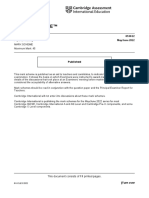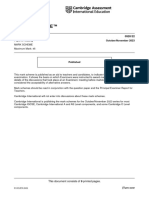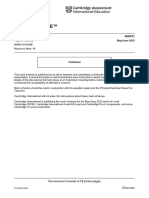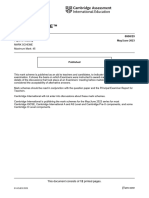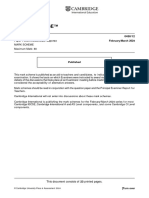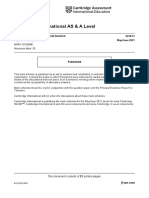7164_s24_ms_22
7164_s24_ms_22
Uploaded by
rokiwix621Copyright:
Available Formats
7164_s24_ms_22
7164_s24_ms_22
Uploaded by
rokiwix621Copyright
Available Formats
Share this document
Did you find this document useful?
Is this content inappropriate?
Copyright:
Available Formats
7164_s24_ms_22
7164_s24_ms_22
Uploaded by
rokiwix621Copyright:
Available Formats
Cambridge IGCSE™ (9–1)
ITALIAN 7164/22
Paper 2 Reading May/June 2024
MARK SCHEME
Maximum Mark: 45
Published
This mark scheme is published as an aid to teachers and candidates, to indicate the requirements of the
examination. It shows the basis on which Examiners were instructed to award marks. It does not indicate the
details of the discussions that took place at an Examiners’ meeting before marking began, which would have
considered the acceptability of alternative answers.
Mark schemes should be read in conjunction with the question paper and the Principal Examiner Report for
Teachers.
Cambridge International will not enter into discussions about these mark schemes.
Cambridge International is publishing the mark schemes for the May/June 2024 series for most
Cambridge IGCSE, Cambridge International A and AS Level and Cambridge Pre-U components, and some
Cambridge O Level components.
This document consists of 10 printed pages.
© Cambridge University Press & Assessment 2024 [Turn over
7164/22 Cambridge IGCSE (9–1) – Mark Scheme May/June 2024
PUBLISHED
Generic Marking Principles
These general marking principles must be applied by all examiners when marking candidate answers. They should be applied alongside the
specific content of the mark scheme or generic level descriptions for a question. Each question paper and mark scheme will also comply with these
marking principles.
GENERIC MARKING PRINCIPLE 1:
Marks must be awarded in line with:
the specific content of the mark scheme or the generic level descriptors for the question
the specific skills defined in the mark scheme or in the generic level descriptors for the question
the standard of response required by a candidate as exemplified by the standardisation scripts.
GENERIC MARKING PRINCIPLE 2:
Marks awarded are always whole marks (not half marks, or other fractions).
GENERIC MARKING PRINCIPLE 3:
Marks must be awarded positively:
marks are awarded for correct/valid answers, as defined in the mark scheme. However, credit is given for valid answers which go beyond
the scope of the syllabus and mark scheme, referring to your Team Leader as appropriate
marks are awarded when candidates clearly demonstrate what they know and can do
marks are not deducted for errors
marks are not deducted for omissions
answers should only be judged on the quality of spelling, punctuation and grammar when these features are specifically assessed by the
question as indicated by the mark scheme. The meaning, however, should be unambiguous.
GENERIC MARKING PRINCIPLE 4:
Rules must be applied consistently, e.g. in situations where candidates have not followed instructions or in the application of generic level
descriptors.
© Cambridge University Press & Assessment 2024 Page 2 of 10
7164/22 Cambridge IGCSE (9–1) – Mark Scheme May/June 2024
PUBLISHED
GENERIC MARKING PRINCIPLE 5:
Marks should be awarded using the full range of marks defined in the mark scheme for the question (however; the use of the full mark range may
be limited according to the quality of the candidate responses seen).
GENERIC MARKING PRINCIPLE 6:
Marks awarded are based solely on the requirements as defined in the mark scheme. Marks should not be awarded with grade thresholds or
grade descriptors in mind.
© Cambridge University Press & Assessment 2024 Page 3 of 10
7164/22 Cambridge IGCSE (9–1) – Mark Scheme May/June 2024
PUBLISHED
Additional Guidance
The following guidance underpins the detailed instructions provided in the mark scheme. Where a decision is taken to deviate from this guidance
for a particular question, this will be specified in the mark scheme.
Often the additional guidance points will have to be weighed up against each other, e.g. the answer might look or sound like the intended
word/phrase in Spanish, but if what the candidate has written means something different in Italian from what is expected, the mark cannot be
awarded.
It is not possible to list all acceptable alternatives in the mark scheme. If you encounter an answer which is not covered by the mark scheme, you
will need to make a decision about whether it communicates the required elements (in consultation with your Team Leader if necessary, or with
your Product Manager if you are a single examiner), and award marks accordingly.
Crossing out:
(a) If a candidate changes his/her mind about an answer and crosses out an attempt, award a mark if the final attempt is correct.
(b) If a candidate crosses out an answer to a whole question but makes no second attempt at it, mark the crossed-out work.
More than the stipulated number of boxes ticked/crossed by the candidate:
(a) If more than one attempt is visible but the candidate has clearly indicated which attempt is his/her final answer (e.g. by crossing out
other attempts or by annotating the script in some way), mark in the usual way.
(b) If two attempts are visible (e.g. two boxes ticked instead of the one box stipulated), and neither has been crossed out/discounted by
the candidate, no mark can be awarded.
For questions requiring more than one element for the answer, 1 and 2, where the answers are interchangeable:
(a) Both of the correct answers are on line 1 and line 2 blank (or vice versa) = 2 marks
(b) Both correct answers on line 1 and line 2 contains a wrong answer (or vice versa) = 1 mark
© Cambridge University Press & Assessment 2024 Page 4 of 10
7164/22 Cambridge IGCSE (9–1) – Mark Scheme May/June 2024
PUBLISHED
Mark for communication: Answers requiring the use of Italian (rather than a non-verbal response) should be marked for communication.
Tolerate inaccuracies provided that the message is clear. However, do not accept incorrect Italian if the word written by the candidate means
something else in Italian (unless the mark scheme specifies otherwise).
(a) If you read aloud what the candidate has written, does it sound like the correct answer? Would a native speaker of Italian understand
it?
(b) Does what the candidate has written look like the correct answer, e.g. one letter missing but no other word created? Would a native
speaker of Italian understand it?
(c) The subject needs to be unambiguous. Possessives and personal pronouns need to be used in such a way as to make the answer
unambiguous.
Annotations used in the mark scheme:
(a) INV = invalidation. This is used when the additional material included by the candidate is judged to invalidate an otherwise correct
answer and therefore prevents him/her from scoring the mark. (INV = 0)
(b) tc = ‘tout court’. This means that, on its own, the material is not sufficient to score the mark.
(c) HA = harmless addition. This means that the candidate has included additional material which, in conjunction with the correct answer,
does not prevent him/her from scoring the mark.
No response and ‘0’ marks:
(a) Award NR (no response):
If there is nothing written at all in the answer space or
If there is only a comment which does not in any way relate to the question being asked (e.g. ‘can’t do’ or ‘don’t know’) or
If there is only a mark which isn’t an attempt at the question (e.g. a dash, a question mark).
(b) Award 0:
If there is any attempt that earns no credit, e.g. the candidate has copied out part or all of the question.
© Cambridge University Press & Assessment 2024 Page 5 of 10
7164/22 Cambridge IGCSE (9–1) – Mark Scheme May/June 2024
PUBLISHED
Extra material: Candidates need to answer the questions in such a way as to demonstrate that they have understood the text. The mark
scheme cannot cover all eventualities so where specific instructions are not provided, the examiner must check the text to ensure that the
correct elements which would attract the mark are not contradicted or distorted by any extra material. The following general rules should be
applied:
(a) Extra material, mentioned in the This is acceptable and is not penalised.
mark scheme, which reinforces
the correct answer or in itself
constitutes an alternative correct
answer:
(b) Extra material which constitutes The examiner needs to decide, by consulting the transcript/text and the Team Leader if necessary,
an alternative answer, but which whether the alternative answer constitutes:
is not explicitly mentioned in (i) an alternative correct answer, in which case this falls into category (a) and the answer should be
the mark scheme: rewarded, or
(ii) an answer which on its own would be rejected, in which case this falls into category (c) and the
answer should be rejected.
(c) Extra material which constitutes This puts the examiner in the position of having to ‘choose’ which the intended answer is. The
an alternative answer examiner cannot therefore be sure what the candidate has understood and the mark cannot be
specifically rejected in the mark awarded.
scheme:
(d) Extra material which distorts or This affects communication. The examiner cannot be sure what the candidate has understood and
contradicts the correct answer: therefore the mark cannot be awarded.
(e) Extra material introduced by the This affects communication. The examiner cannot be sure what the candidate has understood and
candidate and which does not therefore the mark cannot be awarded. It can sometimes be difficult to draw the line between what
feature in the original text: is a deduction made by an able candidate on the basis of what they have read and pure
guesswork. Therefore, where a particular answer is not covered by the mark scheme, the examiner
should consult the Team Leader.
© Cambridge University Press & Assessment 2024 Page 6 of 10
7164/22 Cambridge IGCSE (9–1) – Mark Scheme May/June 2024
PUBLISHED
Detailed Mark Scheme
Question Answer Marks Guidance
1(a) F 1
1(b) E 1
1(c) D 1
1(d) B 1
1(e) A 1
Question Answer Marks Guidance
2(a) C 1
2(b) E 1
2(c) A 1
2(d) D 1
2(e) B 1
© Cambridge University Press & Assessment 2024 Page 7 of 10
7164/22 Cambridge IGCSE (9–1) – Mark Scheme May/June 2024
PUBLISHED
Question Answer Marks Guidance
3(a) C 1
3(b) A 1
3(c) C 1
3(d) B 1
3(e) A 1
3(f) C 1
3(g) B 1
© Cambridge University Press & Assessment 2024 Page 8 of 10
7164/22 Cambridge IGCSE (9–1) – Mark Scheme May/June 2024
PUBLISHED
Question Answer Marks Guidance
Before marking Question 4, read the section Additional Guidance.
4(a) un (vecchio) amico (di Aaden) 1
4(b) sabato 1
4(c) aveva esami 1
4(d) Dieci / 10 minuti 1
4(e) (accanto) all’ingresso (del teatro) 1 Accept: al teatro
4(f) In either order: 1
per ascoltare
per applaudire 1
4(g) sua cugina / la cugina 1
4(h) la commessa 1
4(i) nuotare (in mare) 1
4(j) stavano prendendo il sole / prendevano il sole 1 Don’t accept: prendendo il sole/insist on past tense
4(k) per cenare con i (suoi) genitori 1
Question Answer Marks Guidance
5 a7 5
b4
c6
d2
e8
© Cambridge University Press & Assessment 2024 Page 9 of 10
7164/22 Cambridge IGCSE (9–1) – Mark Scheme May/June 2024
PUBLISHED
Question Answer Marks Guidance
Before marking Question 6, read the section Additional Guidance.
6(a) (per) il lavoro che fa 1
6(b) ballerina 1
6(c) che questo sogno non era realistico / che il suo sogno non 1
era realistico
6(d) In either order: Don’t accept: direct lifting from the text
(era) fisicamente duro 1
(era) mal pagato 1
6(e) si è innamorata del lavoro 1 Insist on the accent on è
6(f) perché aveva trovato la sua professione giusta 1 Insist on: giusta
6(g) (da) persone cresciute a Roma 1
6(h) di aprire gli occhi dei suoi clienti 1
6(i) In either order: Answer must contain a verb and più
Insist on the accent on è
la tiene più vicina alla natura 1
la sua vita è più sana 1
© Cambridge University Press & Assessment 2024 Page 10 of 10
You might also like
- Cambridge IGCSE™: Spanish 0530/21Document11 pagesCambridge IGCSE™: Spanish 0530/21komalds88No ratings yet
- 0520_s24_ms_23Document8 pages0520_s24_ms_23savyam.batra.batra.1No ratings yet
- Cambridge IGCSE™: French 0520/22Document8 pagesCambridge IGCSE™: French 0520/22Anshita RajeshNo ratings yet
- Cambridge IGCSE™: French 0520/21Document10 pagesCambridge IGCSE™: French 0520/21Madalitso PhiriNo ratings yet
- Cambridge IGCSE™: Spanish 0530/22 May/June 2022Document11 pagesCambridge IGCSE™: Spanish 0530/22 May/June 2022ParvNo ratings yet
- Cambridge IGCSE™: French 0520/23 May/June 2021Document8 pagesCambridge IGCSE™: French 0520/23 May/June 2021doshiraj2008No ratings yet
- Cambridge IGCSE™: Foreign Language Spanish 0530/22 February/March 2022Document10 pagesCambridge IGCSE™: Foreign Language Spanish 0530/22 February/March 2022Prisha DangNo ratings yet
- 0520 - s23 - Ms - 21 (1) FrenchDocument10 pages0520 - s23 - Ms - 21 (1) Frenchherogada06No ratings yet
- Cambridge IGCSE™: French 0520/22Document8 pagesCambridge IGCSE™: French 0520/22John MutarauswaNo ratings yet
- Cambridge IGCSE™: German 0525/21Document12 pagesCambridge IGCSE™: German 0525/21Hayden YeungNo ratings yet
- Cambridge IGCSE ™: French 0520/22Document9 pagesCambridge IGCSE ™: French 0520/22DJ SAUCY LsoNo ratings yet
- Cambridge IGCSE ™: FrenchDocument9 pagesCambridge IGCSE ™: FrenchDe DNo ratings yet
- Cambridge IGCSE™: French 0520/23Document8 pagesCambridge IGCSE™: French 0520/23Christiaan Marais BoshoffNo ratings yet
- Cambridge IGCSE™: French 0520/22 February/March 2022Document8 pagesCambridge IGCSE™: French 0520/22 February/March 2022Aahana SinghalNo ratings yet
- Cambridge IGCSE™: Malay 0546/22 May/June 2022Document10 pagesCambridge IGCSE™: Malay 0546/22 May/June 2022nora dilaNo ratings yet
- 0520_s22_ms_23Document8 pages0520_s22_ms_23FantasticMeerNo ratings yet
- Cambridge IGCSE ™: Spanish 0530/21Document11 pagesCambridge IGCSE ™: Spanish 0530/21Zenia GonzalezNo ratings yet
- Cambridge IGCSE™: French 0520/22 May/June 2021Document8 pagesCambridge IGCSE™: French 0520/22 May/June 2021vridhi bhanushali100% (1)
- Cambridge IGCSE™: French 0520/22 October/November 2021Document9 pagesCambridge IGCSE™: French 0520/22 October/November 2021vintiNo ratings yet
- Cambridge IGCSE ™: Spanish 0530/22Document11 pagesCambridge IGCSE ™: Spanish 0530/22Zenia GonzalezNo ratings yet
- Cambridge IGCSE ™: French 0520/23 October/November 2022Document8 pagesCambridge IGCSE ™: French 0520/23 October/November 2022doshiraj2008No ratings yet
- 0520_w22_ms_21Document8 pages0520_w22_ms_21FantasticMeerNo ratings yet
- 0530_s21_ms_22Document10 pages0530_s21_ms_22taraknathindiaNo ratings yet
- Cambridge IGCSE™: Spanish 0530/21Document12 pagesCambridge IGCSE™: Spanish 0530/21angie.o.o420No ratings yet
- 0520_w22_ms_22Document10 pages0520_w22_ms_22FantasticMeerNo ratings yet
- Igcse MalayDocument12 pagesIgcse MalaynoorenNo ratings yet
- Cambridge IGCSE™: Spanish 0530/23Document12 pagesCambridge IGCSE™: Spanish 0530/23sinojiayogNo ratings yet
- Cambridge IGCSE™: Foreign Language Spanish 0530/22 March 2021Document10 pagesCambridge IGCSE™: Foreign Language Spanish 0530/22 March 2021Vidhi ChhedaNo ratings yet
- Cambridge IGCSE™: Spanish 0530/21 October/November 2021Document11 pagesCambridge IGCSE™: Spanish 0530/21 October/November 2021sufxalkNo ratings yet
- June 2021 Mark Scheme 11Document10 pagesJune 2021 Mark Scheme 11Carrisa WNo ratings yet
- Cambridge IGCSE™ (9-1) : German 7159/22Document14 pagesCambridge IGCSE™ (9-1) : German 7159/22Heba MohamedNo ratings yet
- 7164_s24_ms_42Document13 pages7164_s24_ms_42rokiwix621No ratings yet
- Reading-0546 s23 Ms 22gggDocument11 pagesReading-0546 s23 Ms 22gggMohamedNo ratings yet
- 0520 Intro Otg Ms p2Document8 pages0520 Intro Otg Ms p2R ArivalaganNo ratings yet
- J21 Paper 22 AnsDocument12 pagesJ21 Paper 22 Ansmya hayleyNo ratings yet
- Cambridge IGCSE™: Mandarin Chinese 0547/22Document10 pagesCambridge IGCSE™: Mandarin Chinese 0547/22John AyubNo ratings yet
- June 2021 Mark Scheme Paper 21Document10 pagesJune 2021 Mark Scheme Paper 21hebaNo ratings yet
- November 2020 Mark Scheme Paper 13Document14 pagesNovember 2020 Mark Scheme Paper 13Andreea PopescuNo ratings yet
- 646828-june-2021-mark-scheme-paper-02Document13 pages646828-june-2021-mark-scheme-paper-02randima adikariNo ratings yet
- Cambridge IGCSE™: Mandarin Chinese 0547/11 May/June 2020Document10 pagesCambridge IGCSE™: Mandarin Chinese 0547/11 May/June 2020ONo ratings yet
- Cambridge IGCSE™: Mandarin Chinese 0547/21Document10 pagesCambridge IGCSE™: Mandarin Chinese 0547/21John AyubNo ratings yet
- Cambridge IGCSE™ (9-1) : French 7156/22 October/November 2020Document14 pagesCambridge IGCSE™ (9-1) : French 7156/22 October/November 2020MonaNo ratings yet
- Cambridge IGCSE™: Mandarin Chinese 0547/23Document10 pagesCambridge IGCSE™: Mandarin Chinese 0547/23John AyubNo ratings yet
- Cambridge IGCSE ™: German 0525/22 October/November 2022Document14 pagesCambridge IGCSE ™: German 0525/22 October/November 2022hebaNo ratings yet
- Cambridge IGCSE ™: Business Studies 0450/12Document23 pagesCambridge IGCSE ™: Business Studies 0450/12AHMADNo ratings yet
- 0450 BUSINESSSTUDIES Paper1 June 2024Document24 pages0450 BUSINESSSTUDIES Paper1 June 2024spied-donated-awryNo ratings yet
- Cambridge IGCSE™: French 0520/22 March 2020Document13 pagesCambridge IGCSE™: French 0520/22 March 2020Nipun JhalaniNo ratings yet
- Cambridge IGCSE™: Malay 0546/23Document11 pagesCambridge IGCSE™: Malay 0546/23Penang Home TuitionNo ratings yet
- Cambridge IGCSE™: French 0520/12 March 2020Document14 pagesCambridge IGCSE™: French 0520/12 March 2020Nipun JhalaniNo ratings yet
- Cambridge International AS & A Level: Business 9609/11 May/June 2022Document18 pagesCambridge International AS & A Level: Business 9609/11 May/June 2022Tawanda BlackwatchNo ratings yet
- Cambridge IGCSE™: Business Studies 0450/13 May/June 2022Document22 pagesCambridge IGCSE™: Business Studies 0450/13 May/June 2022Anh Phạm MinhNo ratings yet
- 9239_s24_ms_11Document25 pages9239_s24_ms_11lolitscringeNo ratings yet
- Cambridge International AS & A Level: Sociology 9699/11 May/June 2022Document17 pagesCambridge International AS & A Level: Sociology 9699/11 May/June 2022katsandeNo ratings yet
- Cambridge International AS & A Level: Business 9609/12 May/June 2022Document20 pagesCambridge International AS & A Level: Business 9609/12 May/June 2022fopabip33No ratings yet
- June 2022 Mark Scheme Paper 11Document20 pagesJune 2022 Mark Scheme Paper 11kinggatete2005No ratings yet
- Cambridge International AS & A Level: Global Perspectives and Research 9239/11 May/June 2021Document21 pagesCambridge International AS & A Level: Global Perspectives and Research 9239/11 May/June 2021Hassan AsadullahNo ratings yet
- Cambridge IGCSE™: Short Answer and Data ResponseDocument23 pagesCambridge IGCSE™: Short Answer and Data ResponseTran LocNo ratings yet
- 0523 s18 Ms 1 PDFDocument15 pages0523 s18 Ms 1 PDFtechang1No ratings yet
- 9609_s24_ms_42Document16 pages9609_s24_ms_42Dio HanNo ratings yet
- 8 Somaj Kormi Special Suggestion 2022Document36 pages8 Somaj Kormi Special Suggestion 2022asadasaduzzaman938No ratings yet
- Conditionals: English 5Document8 pagesConditionals: English 5Damaris CarrilloNo ratings yet
- C1 - DeCuongChiTiet - SVDocument13 pagesC1 - DeCuongChiTiet - SVTú NguyễnNo ratings yet
- English For Business I CronDocument2 pagesEnglish For Business I CronEmerzon GuevaraNo ratings yet
- Exercises. For The ExamDocument3 pagesExercises. For The ExamkevinNo ratings yet
- Adjectives U Nit 1: Japanese Girls Were Wearing Long Kimonos and Two IndianDocument12 pagesAdjectives U Nit 1: Japanese Girls Were Wearing Long Kimonos and Two IndianNino BluashviliNo ratings yet
- Ing - Infinitives +list of VerbsDocument4 pagesIng - Infinitives +list of Verbsvictor chamorroNo ratings yet
- Present PerfectDocument1 pagePresent PerfectAbichi NeedNo ratings yet
- EAPP-subject Verb AgreementDocument3 pagesEAPP-subject Verb AgreementJOVIE GABUTANNo ratings yet
- Chapter 1 Parts of SpeechDocument4 pagesChapter 1 Parts of SpeechAhmad SaifiNo ratings yet
- Language Learner Profile 1Document11 pagesLanguage Learner Profile 1api-224695265No ratings yet
- If Clause: 1. Rumus If Clause / Conditional Sentence Type 1 If + Subjek + V1 - S + Will + V1Document13 pagesIf Clause: 1. Rumus If Clause / Conditional Sentence Type 1 If + Subjek + V1 - S + Will + V1nabila purbayaNo ratings yet
- Reported SpeechDocument42 pagesReported SpeechMaria Eduarda LinsNo ratings yet
- Simple Present Tense: For RoutinesDocument20 pagesSimple Present Tense: For RoutinesjulianaNo ratings yet
- Comparatives and Superlatives 37097Document2 pagesComparatives and Superlatives 37097Biljana PetrovskaNo ratings yet
- English 9 Test QuestionsDocument3 pagesEnglish 9 Test Questionsshie bardoquilloNo ratings yet
- Bahasa Ing Kel6Document9 pagesBahasa Ing Kel6lelapermanasari29No ratings yet
- Elephants EditDocument9 pagesElephants EditMashirNo ratings yet
- Tiongson Elementary School: First Periodical TestDocument3 pagesTiongson Elementary School: First Periodical TestRaymund BondeNo ratings yet
- Infinitives: To Write Not To Write To Read Not To Read To Sleep Not To SleepDocument4 pagesInfinitives: To Write Not To Write To Read Not To Read To Sleep Not To SleepJoshua Kevin SolamoNo ratings yet
- CH40 Grammar - Pronoun WS 2Document9 pagesCH40 Grammar - Pronoun WS 2dmarmatNo ratings yet
- 5th MEETINGDocument15 pages5th MEETINGLL. AGHYL ANUGERAH MAHESANo ratings yet
- Structure, Skill 6-10Document10 pagesStructure, Skill 6-10leon_blizzaraNo ratings yet
- Prepositions & Articles PDFDocument12 pagesPrepositions & Articles PDFAl-Ami SarkerNo ratings yet
- Present Tenses:: Grammar Rules and Basic PractiseDocument8 pagesPresent Tenses:: Grammar Rules and Basic PractisePilar Pérez Sánchez100% (1)
- Mechanics & Precautions in Writing Research Report: Submitted To: Submitted byDocument23 pagesMechanics & Precautions in Writing Research Report: Submitted To: Submitted byohlyanaartiNo ratings yet
- BK Inno 000179 PDFDocument427 pagesBK Inno 000179 PDFKornfeld Zeiwert HenryNo ratings yet
- Comparatives and Superlatives Interactive PracticeDocument5 pagesComparatives and Superlatives Interactive PracticeCarlos Fernando Alvarado MoranNo ratings yet
- DLP-G-9 VerbalsDocument4 pagesDLP-G-9 VerbalsHaidee Indecio100% (1)
- RPubs - Text-Mining With Rvest and QdapDocument17 pagesRPubs - Text-Mining With Rvest and QdapgprasadatvuNo ratings yet




